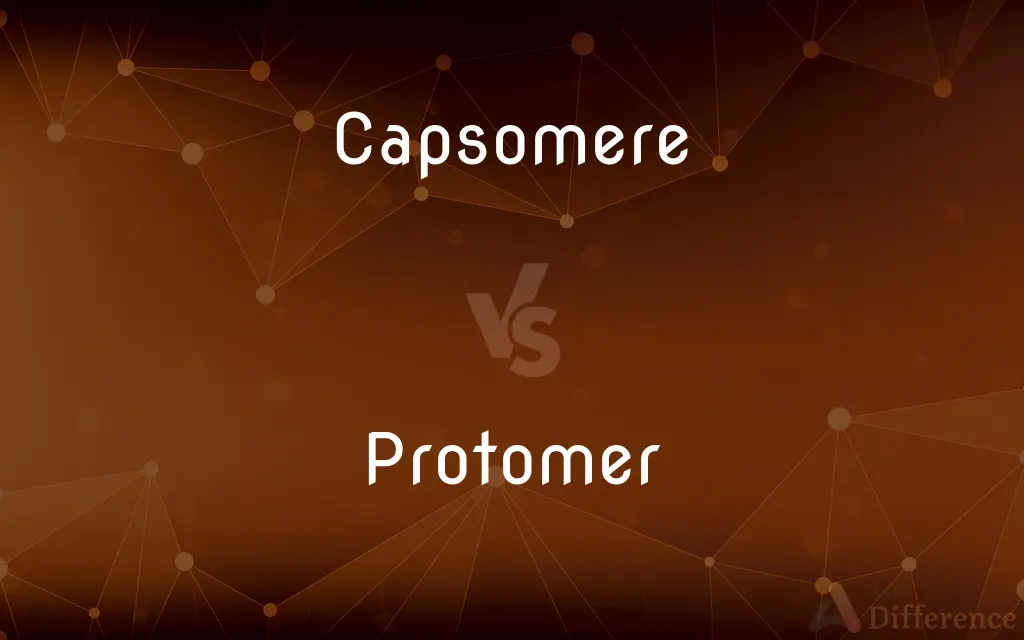Capsomere vs. Protomer — What's the Difference?
By Tayyaba Rehman & Maham Liaqat — Updated on April 2, 2024
Capsomeres are the protein subunits forming the capsid of a virus, while protomers are the structural subunits that assemble into capsomeres.

Difference Between Capsomere and Protomer
Table of Contents
ADVERTISEMENT
Key Differences
Capsomeres are the basic building blocks of the capsid, the protein shell that encases the genetic material of a virus. These subunits can self-assemble into the protective capsid structure. On the other hand, protomers are even more fundamental structural units, often consisting of a single protein or a complex of proteins, that come together to form capsomeres.
The primary role of capsomeres is to provide a protective shell for viral genetic material and to assist in the attachment of the virus to host cells. Protomers, being the building blocks of capsomeres, indirectly contribute to the formation and structural integrity of the viral capsid but do not interact directly with the host cell.
Capsomeres vary in shape and size depending on the type of virus, and their arrangement determines the overall morphology of the virus. Protomers, being the precursor units, dictate the specific structural organization of capsomeres by their shape, charge, and bonding sites.
The study of capsomeres and protomers is crucial in virology and structural biology, as understanding their structure and assembly can aid in the development of antiviral drugs and vaccines. The distinction between these two components emphasizes the hierarchical nature of viral structure assembly.
Comparison Chart
Definition
Protein subunits that form the capsid of a virus
Structural subunits that assemble into capsomeres
ADVERTISEMENT
Role in Virus
Form the protective capsid around viral genetic material
Building blocks of capsomeres
Interaction with Host
Assist in virus attachment to host cells
Do not directly interact with host cells
Structural Level
Second level of viral structure assembly
First level of viral structure assembly
Importance in Research
Key targets for understanding virus attachment and entry
Essential for understanding capsid assembly
Compare with Definitions
Capsomere
Capsomeres determine the overall shape and structure of the viral capsid.
The spherical shape of the virus was due to the hexagonal arrangement of its capsomeres.
Protomer
Understanding protomer assembly is key to antiviral research.
Research on protomer assembly pathways offers insights into stopping virus replication.
Capsomere
Can be targets for antiviral drugs aiming to disrupt the capsid.
The new drug targets specific capsomeres to prevent the virus from assembling correctly.
Protomer
The most basic structural units that aggregate to form capsomeres in a viral capsid.
Protomers arranged in precise patterns are the first step in capsid formation.
Capsomere
Play a crucial role in the virus’s ability to attach to and invade host cells.
Modifications in capsomere structure could affect the virus's infectivity.
Protomer
Consist of single or multiple proteins that undergo self-assembly.
Each protomer in the virus was composed of a complex of two different proteins.
Capsomere
Protein subunits that self-assemble to form the capsid of a virus, protecting its genetic material.
Scientists studied the capsomeres of the virus to understand how it protects its RNA.
Protomer
Protomers are essential for the hierarchical assembly of viral particles.
The discovery of a new protomer shape could lead to a breakthrough in understanding virus diversity.
Capsomere
The study of capsomeres helps in the development of vaccines.
Vaccine developers used the capsomere structure to create a mimic that triggers an immune response.
Protomer
The structure and interaction of protomers dictate the final capsid structure.
By altering protomer interactions, scientists could change the capsid's assembly pattern.
Capsomere
The capsomere is a subunit of the capsid, an outer covering of protein that protects the genetic material of a virus. Capsomeres self-assemble to form the capsid.
Protomer
In structural biology, a protomer is the structural unit of an oligomeric protein. It is the smallest unit composed of at least two different protein chains that form a larger hetero-oligomer by association of two or more copies of this unit.
Capsomere
One of the individual subunits that make up a viral capsid.
Protomer
Each of a number of tautomeric molecules which differ from each other only in the position of a proton; a prototropic tautomer.
Capsomere
Any of the individual protein subunits of a viral capsid
Protomer
Each of the protein subunits of which an oligomeric protein is built up.
Protomer
(chemistry) Any prototropic tautomer.
Protomer
(biochemistry) Any of the subunits that constitute an oligomeric protein.
Common Curiosities
Why are capsomeres important in virology?
Capsomeres are crucial for the structural integrity of the virus and its ability to attach to and enter host cells, making them important targets for antiviral strategies.
What distinguishes a capsomere from a protomer?
Capsomeres are the protein units that make up the capsid of a virus, while protomers are the smaller structural units that assemble into capsomeres.
Do all viruses have capsomeres and protomers?
Most viruses have capsids made of capsomeres, which in turn are assembled from protomers, but the complexity and arrangement can vary widely.
How can the study of capsomeres and protomers aid in vaccine development?
Understanding the structure and assembly of capsomeres and protomers can lead to the development of vaccine candidates that mimic virus structures, eliciting an immune response.
Are there any diseases associated with defects in protomer assembly?
While defects in protomer assembly would primarily affect the virus, such defects could make the virus less infectious or alter its pathogenicity, impacting disease outcomes.
How do protomers contribute to the formation of a viral capsid?
Protomers aggregate and interact to form capsomeres, which then assemble into the protective capsid around the virus's genetic material.
Are protomers specific to certain types of viruses?
While the concept of protomers is universal in virology, the specific structure and composition of protomers can vary significantly between different viruses.
Is it possible to visualize protomers and capsomeres?
With advanced imaging techniques like cryo-electron microscopy, scientists can visualize and study the structure of protomers and capsomeres at the molecular level.
Can disrupting protomer assembly affect a virus?
Yes, disrupting protomer assembly can prevent the formation of capsomeres and the capsid, hindering virus replication and infectivity.
Can mutations in protomers affect the viral capsid?
Mutations in protomers can alter their ability to form capsomeres correctly, potentially affecting the capsid's integrity and the virus's infectivity.
Share Your Discovery

Previous Comparison
Political vs. Social
Next Comparison
Night vs. ShadowAuthor Spotlight
Written by
Tayyaba RehmanTayyaba Rehman is a distinguished writer, currently serving as a primary contributor to askdifference.com. As a researcher in semantics and etymology, Tayyaba's passion for the complexity of languages and their distinctions has found a perfect home on the platform. Tayyaba delves into the intricacies of language, distinguishing between commonly confused words and phrases, thereby providing clarity for readers worldwide.
Co-written by
Maham Liaqat















































